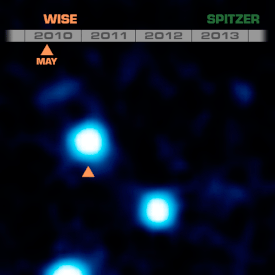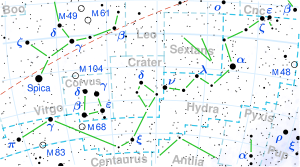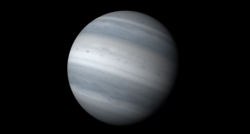 Time-lapsed photo sequence of WISE 0855−0714's movement in the sky using captured images from the WISE and the Spitzer telescopes. [1] | |
| Observation data Epoch J2000 Equinox J2000 | |
|---|---|
| Constellation | Hydra |
| Right ascension | 08h 55m 10.83168s [2] |
| Declination | −07° 14′ 42.5256″ [2] |
| Characteristics | |
| Evolutionary stage | Sub-brown dwarf |
| Spectral type | Y4V [3] [4] |
| Apparent magnitude (J) | 25.00±0.53 [2] |
| Apparent magnitude (H) | 23.83±0.24 [2] |
| Astrometry | |
| Proper motion (μ) |
RA: −8,123.7±1.3
mas/
yr
[3] Dec.: 673.2±1.3 mas/ yr [3] |
| Parallax (π) | 439.0 ± 2.4 mas [3] |
| Distance | 7.43 ± 0.04
ly (2.28 ± 0.01 pc) |
| Details | |
| Mass | ~3–10 [5] MJup |
| Radius | 0.8884 [a] [5] RJup |
| Luminosity | 4.9545×10−8 [b] [5] L☉ |
| Surface gravity (log g) | ~4 [5] cgs |
| Temperature | 285 [5] K |
| Metallicity [Fe/H] | ≈1 [5] dex |
| Age | 1–10 [5] Gyr |
| Other designations | |
| Database references | |
| SIMBAD | data |
Location of WISE 0855−0714 in the constellation
Hydra | |
WISE 0855−0714 (full designation WISE J085510.83−071442.5, [7] or W0855 for short) is a sub-brown dwarf 2.28±0.01 parsecs (7.43±0.04 light-years) [3] from Earth, therefore the fourth- closest star or (sub-) brown dwarf system to the Sun, [1] the discovery of which was announced in April 2014 by Kevin Luhman using data from the Wide-field Infrared Survey Explorer (WISE). [1] As of 2014 [update], WISE 0855−0714 has the third-highest proper motion (8,151.6±1.8 mas/yr) [3] after Barnard's Star (10,300 mas/yr) and Kapteyn's Star (8,600 mas/yr) [7] and the fourth-largest parallax (439.0±2.4 mas) [3] of any known star or brown dwarf. It is also the coldest object of its type found in interstellar space, having a temperature of about 285 K (12 °C; 53 °F). [5]
Characterization
Observations
The WISE object was detected in March 2013, and follow-up observations were taken by the Spitzer Space Telescope and the Gemini North telescope. [1]
Distance
Based on direct observations, WISE 0855−0714 has a large parallax, which specifically relates to its distance from the Solar System. This phenomenon results in a distance of around 7.43±0.04 light-years, [3] with a small margin of error due to the strength of the parallax effect and the clarity of observations. WISE 0855−0714 also has an exceptionally high proper motion. [3]
Spectrometry
Its luminosity in different bands of the thermal infrared in combination with its absolute magnitude—because of its known distance—was used to place it in context of different models; the best characterization of its brightness was in the W2 band of 4.6 μm at an apparent magnitude of 13.89±0.05, though it was brighter into the deeper infrared. [7] Infrared images taken with the Magellan Baade Telescope suggest evidence of sulfide clouds below water ice clouds. [8]
Near- and mid-infrared spectra in the L- and M-band were taken with the GNIRS instrument on the Gemini North Telescope. The M-band (4.5–5.1 μm) spectrum is dominated by water vapour (H2O) absorption. The L-band (3.4–4.14 μm) spectrum is dominated by methane absorption. Both the M- and L-band surprisingly have no detection of phosphine (PH3), which appears in the atmosphere of Jupiter. The M-band spectrum shows evidence for water ice clouds and the near-infrared photometry WISE 0855 is faint compared to models, suggesting an additional absorber, probably clouds made of ammonium dihydrogen phosphate (NH4)(H2PO4), which are below the water ice clouds. [9] [10] An approved JWST proposal describes how the team is planning to use a near-infrared time-series to study the hydrological cycle in the atmosphere of WISE 0855 with NIRSpec. [11]
Observations with NIRSpec detected methane (CH4), water vapor (H2O), ammonia (NH3) and carbon monoxide (CO) in the atmosphere, but was not able to confirm any phosphine (PH3) or carbon dioxide (CO2) in the atmosphere. Water ice clouds are also not confirmed and the spectrum is well matched with a cloudless model. Future modelling and inclusion of observations at longer wavelengths with MIRI might help to reveal clouds in WISE 0855. [5]
Variability
Variability of WISE 0855 in the infrared was measured with Spitzer IRAC. A relative small amplitude of 4–5% was measured. Water ice cloud models predicted a large amplitude. This small amplitude might suggest that the hemispheres of WISE 0855 have very small deviation in cloud coverage. The light curve is too irregular to produce a good fit and rotation periods between 9.7 and 14 hours were measured. [12]
Physical parameters
Based on models of brown dwarfs WISE 0855−0714's is estimated to have a mass of 3 to 10 MJup. [1] This mass is in the range of a sub-brown dwarf or other planetary-mass object.
As of 2003, the International Astronomical Union considers an object with a mass above 13 MJup, capable of fusing deuterium, to be a brown dwarf. A lighter object and one orbiting another object is considered a planet. [13] However, if the distinction is based on how the object formed then it might be considered a failed star, a theory advanced for the object Cha 110913-773444. [14]
Combining its luminosity, distance, and mass it is estimated to be the coldest-known brown dwarf, with a modeled effective temperature of 225 to 260 K (−48 to −13 °C; −55 to 8 °F), depending on the model. [1] Models matching the NIRSpec spectrum are well fitted with a temperature of 285 K (12°C; 53 °F). [5]
Gallery
-
JWST NIRCam observation of W0855 (orange "star" at the center)
-
The position of WISE 0855−0714 on a radar map among all stellar objects or stellar systems within 9 light years (ly) from the map's center, the Sun (Sol). The diamond-shapes are their positions entered according to right ascension in hours angle (indicated at the edge of the map's reference disc), and according to their declination. The second mark shows each's distance from Sol, with the concentric circles indicating the distance in steps of one ly.
-
Artist's impression of a water cloud planet. It was suggested that WISE 0855 has water ice clouds.
See also
- CFBDSIR 2149-0403, the first free-floating object with a confirmed mass below 13 MJup.
- List of nearest stars and brown dwarfs
- Luhman 16
- PSO J318.5-22
- Superjupiter
- Sub-brown dwarf
- List of Y-dwarfs
Notes
- ^ Radius derived from a effective temperature of 285 K and a luminosity of 0.000000049545 L☉. These values, in the Stefan–Boltzmann law (, where T is the effective temperature and L is the luminosity), derive a radius of 0.0913 R☉, which, converted to Jupiter radius (RJ), gives about 0.8884 RJ.
- ^ Derived from a luminosity logarithm of -7.305
References
- ^ a b c d e f Clavin, Whitney; Harrington, J. D. (25 April 2014). "NASA's Spitzer and WISE Telescopes Find Close, Cold Neighbor of Sun". NASA.gov. Archived from the original on 26 April 2014.
- ^ a b c d "WISEA J085510.74-071442.5". SIMBAD. Centre de données astronomiques de Strasbourg. Retrieved 15 May 2017.
- ^ a b c d e f g h Kirkpatrick, J. Davy; Gelino, Christopher R.; et al. (2021). "The Field Substellar Mass Function Based on the Full-sky 20 pc Census of 525 L, T, and Y Dwarfs". The Astrophysical Journal Supplement Series. 253 (1): 7. arXiv: 2011.11616. Bibcode: 2021ApJS..253....7K. doi: 10.3847/1538-4365/abd107. S2CID 227126954.
- ^ Mamajek, Eric. "A Modern Mean Dwarf Stellar Color and Effective Temperature Sequence". Retrieved 7 February 2021.
- ^ a b c d e f g h i j Luhman, K. L.; Tremblin, P.; et al. (January 2024). "JWST/NIRSpec Observations of the Coldest Known Brown Dwarf". The Astronomical Journal. 167 (1): 5. arXiv: 2311.17316. Bibcode: 2024AJ....167....5L. doi: 10.3847/1538-3881/ad0b72. ISSN 0004-6256.
- ^ Golovin, Alex; Reffert, Sabine; Just, Andreas; Jordan, Stefan; Vani, Akash; Jahreiß, Hartmut (November 2022). "The Fifth Catalogue of Nearby Stars (CNS5)". Astronomy & Astrophysics. 670: A19. arXiv: 2211.01449. Bibcode: 2023A&A...670A..19G. doi: 10.1051/0004-6361/202244250. S2CID 253264922. Catalogue can be accessed here.
- ^ a b c Luhman, Kevin L. (21 April 2014). "Discovery of a ~250 K Brown Dwarf at 2 pc from the Sun". The Astrophysical Journal Letters. 786 (2): L18. arXiv: 1404.6501. Bibcode: 2014ApJ...786L..18L. doi: 10.1088/2041-8205/786/2/L18. S2CID 119102654.
- ^ Faherty, Jacqueline K.; Tinney, C. G.; Skemer, Andrew; Monson, Andrew J. (August 2014). "Indications of Water Clouds in the Coldest Known Brown Dwarf". Astrophysical Journal Letters. 793 (1): L16. arXiv: 1408.4671. Bibcode: 2014ApJ...793L..16F. doi: 10.1088/2041-8205/793/1/L16. S2CID 119246100.
- ^ Skemer, Andrew J.; Morley, Caroline V.; Allers, Katelyn N.; Geballe, Thomas R.; Marley, Mark S.; Fortney, Jonathan J.; Faherty, Jacqueline K.; Bjoraker, Gordon L.; Lupu, Roxana (1 August 2016). "The First Spectrum of the Coldest Brown Dwarf". The Astrophysical Journal. 826 (2): L17. arXiv: 1605.04902. Bibcode: 2016ApJ...826L..17S. doi: 10.3847/2041-8205/826/2/L17. ISSN 0004-637X.
- ^ Morley, Caroline V.; Skemer, Andrew J.; Allers, Katelyn N.; Marley, Mark. S.; Faherty, Jacqueline K.; Visscher, Channon; Beiler, Samuel A.; Miles, Brittany E.; Lupu, Roxana; Freedman, Richard S.; Fortney, Jonathan J.; Geballe, Thomas R.; Bjoraker, Gordon L. (1 May 2018). "An L Band Spectrum of the Coldest Brown Dwarf". The Astrophysical Journal. 858 (2): 97. arXiv: 1804.07771. Bibcode: 2018ApJ...858...97M. doi: 10.3847/1538-4357/aabe8b. ISSN 0004-637X.
- ^ Skemer, Andrew; Miles, Brittany E.; Morley, Caroline; Allers, Katelyn; Bjoraker, Gordon; Carter, Aarynn; Cushing, Michael C.; Faherty, Jacqueline Kelly; Fortney, Jonathan; Freedman, Richard; Geballe, Thomas R.; Line, Michael; Lupu, Roxana; Marley, Mark S.; Martin, Emily (1 March 2021). "Water Ice Clouds and Weather on the Coldest Brown Dwarf". JWST Proposal. Cycle 1: 2327. Bibcode: 2021jwst.prop.2327S.
- ^ Esplin, T. L.; Luhman, K. L.; Cushing, M. C.; Hardegree-Ullman, K. K.; Trucks, J. L.; Burgasser, A. J.; Schneider, A. C. (1 November 2016). "Photometric Monitoring of the Coldest Known Brown Dwarf with the Spitzer Space Telescope". The Astrophysical Journal. 832 (1): 58. arXiv: 1609.05850. Bibcode: 2016ApJ...832...58E. doi: 10.3847/0004-637X/832/1/58. ISSN 0004-637X.
- ^ "Working Group on Extrasolar Planets: Definition of a "Planet"". Working Group on Extrasolar Planets of the International Astronomical Union. 28 February 2003. Archived from the original on 16 December 2014. Retrieved 28 April 2014.
- ^ Papadopoulos, Leonidas (28 April 2014). "Between the Planet and the Star: A New Ultra-Cold, Sub-Stellar Object Discovered Close to Sun". AmericaSpace.com. Retrieved 28 April 2014.
Further reading
- Beichman, C.; Gelino, Christopher R.; et al. (2014). "WISE Y Dwarfs As Probes of the Brown Dwarf-Exoplanet Connection". The Astrophysical Journal. 783 (2): 68. arXiv: 1401.1194. Bibcode: 2014ApJ...783...68B. doi: 10.1088/0004-637X/783/2/68. S2CID 119302072. (Note: WISE 0855−0714 is not mentioned in this paper; it is about other Y-type objects discovered by WISE.)
- Luhman, Kevin L.; Esplin, Taran L. (2014). "A New Parallax Measurement for the Coldest Known Brown Dwarf". The Astrophysical Journal. 796 (1): 6. arXiv: 1409.5899. Bibcode: 2014ApJ...796....6L. doi: 10.1088/0004-637X/796/1/6. S2CID 119179360.
- Wright, Edward L.; Mainzer, Amy; et al. (2014). "NEOWISE-R Observation of the Coolest Known Brown Dwarf". The Astronomical Journal. 148 (5): 82. arXiv: 1405.7350. Bibcode: 2014AJ....148...82W. doi: 10.1088/0004-6256/148/5/82. S2CID 29278388.
- Tinney, C. G.; Faherty, Jacqueline K.; et al. (November 2014). "The Luminosities of the Coldest Brown Dwarfs". The Astrophysical Journal. 796 (1): 39. arXiv: 1410.0746. Bibcode: 2014ApJ...796...39T. doi: 10.1088/0004-637X/796/1/39.
External links
- WISE J0855-0714 at Solstation.com




